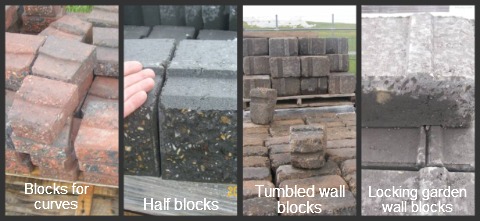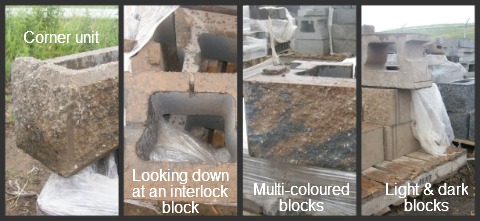B. Landscape Blocks
Manufactured landscape blocks and landscaping bricks are the first products we are going to look at in this series.
These are the most common and easiest to use products for do-it-yourselfers.
Block or brick retaining walls can be assembled much easier and faster than natural stone.
After specializing with natural stone over the years, I am impressed with the new products being introduced in the manufactured lines.
“Tumbled” products have a much more natural look than the squared
off landscaping blocks and bricks. Surface variations, mixing of
colors, and shapes has also brought more appeal to manufactured
products.
Advantages of using manufactured products over natural stone.
The best two features about manufactured products are that they are consistent in shape, and they usually have interlocking qualities. This means that they self-align, and set back (batter), when you are stacking them. This makes it easier for a do-it-yourselfer when building walls. Once you have taken the time to prepare a good base, the rest is easy.
With natural stone walls, much more time and care has to be taken with every level. Proper building techniques must be followed for strength and stability. They will take considerably longer to build than a manufactured block wall. Manufactured products are much easier to work with for do-it-yourselfers.
Choose the right product
The manufacturer will provide brochures with the specifications on uses, and height limits. This is important information to you, as it allows you to choose the right material for your project. You need to be able to distinguish between landscape blocks used for a three foot high retaining wall, and smaller landscape bricks used for a low decorative garden wall.

Garden wall blocks.
You can easily miss the recommended height for a product. I have seen
homeowners make the mistake of building a high retaining wall out of
garden wall bricks, or low decorative wall materials. In this case, the
wall will most likely fail or collapse over time.
Estimating Materials for Walls
Estimating with manufactured products is much easier than a natural product like flagstone or boulders. You should always start by visiting supplier websites for their information on estimating and installing.
The in-store brochures will provide you with the different styles, colors, dimensions of each product, and coverage per square foot, or meter.
We still want to help you to be able to estimate your requirements, so let's look at how we get to the results. There are many different dimensions of bricks and blocks, so let's start by figuring out the dimensions of your wall first.
Take the length of the wall, times the height. This will give you your square footage facing. Knowing the facing dimensions of your wall is all you need to estimate your materials. If you wanted to add in the thickness, this will give you the cubic ft. of your wall.
(Don't forget to factor in the amount of bricks that may be buried if you are building a retaining wall). This may mean some, or all of the bottom course of stone.
Once you have decided on the materials you are going to use, you can adjust your wall measurements to fit with the product you are buying. (This means making your wall dimensions divisible by the product dimensions.) This will allow you to accurately order the right amount of material.
For example:
If your wall is 60 feet long and 3 feet high, you will need to cover 180 square ft. of facing.
If you select a stone that has dimensions of 8 inches long by 6 inches high, convert your wall dimensions to inches.
- 60 feet times 12 inches per foot = 720 inches
720 divided by 8 inches long per brick = 90 bricks per row.
For the height of the wall you need to convert 3 feet to inches.
3 feet times 12 inches per foot = 36 inches.
36 inches divided by 6 inches high per brick = 6 bricks high.
90 x 6 = 540 bricks
Different types of products made.
There are different types of stones that you will need to be familiar with before placing your order. Not all manufactured products will produce these different types. Sometimes you may have to have stone specifically cut by the stone yard. (If you don't have a good saw with a stone blade.)
First, let's look at the pieces you will find available for most walls.

The large wall blocks pictured here come in
light, dark,
and mixed colors. Specially made corner units and capstones
are
also available in this product.
- Standard wall pieces - These are the majority of pieces that will make up the facing in most walls.
- Coping or capstone units - These are usually the same size as a standard unit with the underside having interlock qualities and the top being a cap stone. (Usually with a bit of character to it.)
- Corner Pieces - Most wall products will have 90 degree units to create corners, step downs, and in building pillars as well. Some products will also offer 45 degree corner units. (Make sure you understand that there are right and left corners made.)
- Starter units - These are not always available. They are usually half the facing width of a standard unit. This allows you to offset the joints and stagger the stacking for added interlock stability. If these are not available in the product you are purchasing, you can have a standard unit cut in half.
- TR units - These are used for sharper curves or firepits.
Additional products you may need:
- Lighting units - These usually closely resemble the texture and color of the other stones. They are low voltage and easy to install for safety in and around your yard in the evening.
- Landscape glue/adhesive - This is used to glue down the capstones or coping stones so they don't get kicked, bumped, or moved around and broken.
- Geogrid - This is the specially designed synthetic fabric that locks the wall to the soil behind it. It is usually used in walls over four feet in height, but these laws can vary in different places. If your wall is over a certain height, you may require a stamped approved plan provided by an engineer. It is up to you to know the local laws regarding wall height and construction requirements. If you plan on building a retaining wall over three feet in height you should always check with your local by-law office.
If you are looking for help in building your retaining walls, please visit our module on stone walls in our diy section.
Now it's time to have a look at manufactured patio bricks and paver stones.
______________________________________
Introduction Estimating Materials
Table of Contents: Landscaping Yards
A. Landscaping Yards Introduction
C. Patio Bricks and Paver Stones
F. Buying Rock
H. Other Landscaping Materials
I. Quick Landscaping Estimating Reference
Table of Contents: Buying Soil
______________________________________
Return to the Estimating Materials Introduction
Go to the Dream Yard Home Page
Check out our time and money saving e-book
How to avoid the biggest mistakes made by DIYers, designers, and landscaping companies.
Visitor
Favorites
Giggles 'n' Thoughts





